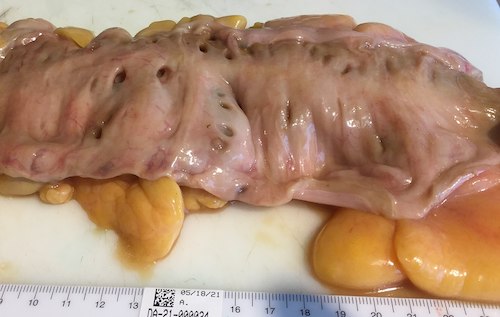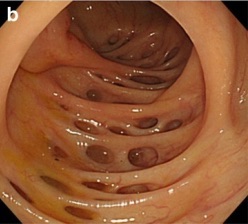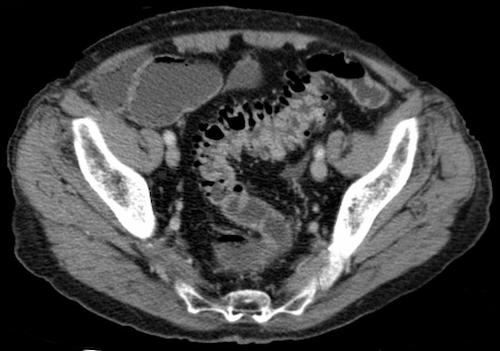Large Intestine: Diverticulosis
Diverticulosis
Definitions
- Diverticulosis: Herniated Diverticulum Through the Colonic Wall
- Diverticular Disease: Clinically Significant or Symptomatic Disease Associated with Diverticulosis
- Diverticular Bleeding: Bleeding from Diverticulum
- Diverticulitis: Inflammation of Diverticulum
- Segmental Colitis Associated with Diverticulosis (SCAD): Segmental Inflammation of the Interdiverticular Colonic Mucosa without Involvement of Diverticular orifices
- Somewhat Overlaps with Inflammatory Bowel Disease
- Symptomatic Uncomplicated Diverticular Disease (SUDD): Persistent Abdominal Pain Due to Diverticulum without Evidence of Bleeding or Inflammation
- Previously Referred to as “Chronic Smoldering Diverticulitis”
Diverticulosis Pathophysiology
- Herniation of Colonic Mucosa/Submucosa Between the Muscularis Propria
- “False”/Pulsion Diverticulum
- Occur at Sites of Vasa Recta Arterial Entrance Through the Muscularis Propria
- Location: Anywhere Along the Colon
- Most Common Site:
- In the West: Sigmoid Colon (95%)
- In Asia: Right Colon
- Not in the Rectum – Tenia Splay Out
- Most Common Site:
- Cause: Increased Intraluminal Pressure & Straining
Risk Factors
- Western Diet (Low Fiber, High Fat & Red Meat)
- Obesity
- Physical Inactivity
- Tobacco
- Seeds/Nuts Are NOT Associated with Diverticulosis or Diverticulitis
Prevalence
- In the West: 5-45%
- 65% by Age 85
- In Asia: 13-25%
Treatment
- Diverticulosis without Diverticular Disease Does Not Need Any Treatment

Diverticulosis 1

Diverticulosis on Colonoscopy 2

Diverticulosis on CT 3
Diverticular Bleeding
Basics
- The Most Common Cause of GI Bleeding
- Incidence in Diverticulosis: 5-15%
- Most Common Source: Right Colon (Often Larger with a Thinner Wall)
- Cause: Arterial Vasa Recta Disruption
- 75% Stop Spontaneously
- 15-25% Lifetime Risk of Rebleeding
GI Bleeding Work-Up
Treatment
- Primary Tx: Colonoscopy (Clipping, Epinephrine Injection, Cauterization or Band Ligation)
- If Fails or Unable to Visualize: Angioembolization
- Surgery:
- Indications:
- Continuous Bleeding > 72 Hours
- Transfusion > 4-6 Unit within 24 Hours
- Rebleeding on Same Admission
- Procedure:
- Bleeding Localized: Segmental Resection/Sigmoidectomy
- Bleeding Not Localized: Total Abdominal Colectomy
- Indications:

Diverticular Bleeding 4
References
- Haggstrom M. Wikimedia Commons. (License: Public Domain)
- Niikura R, Nagata N, Akiyama J, Shimbo T, Uemura N. Hypertension and concomitant arteriosclerotic diseases are risk factors for colonic diverticular bleeding: a case-control study. Int J Colorectal Dis. 2012 Sep;27(9):1137-43. (License: CC BY-2.0)
- Hellerhoff. Wikimedia Commons. (License: CC BY-SA-3.0)
- Kassab I, Dressner R, Gorcey S. Over-the-Scope Clip for Control of a Recurrent Diverticular Bleed. ACG Case Rep J. 2015 Oct 9;3(1):5-6. (License: CC BY-NC-ND-4.0)